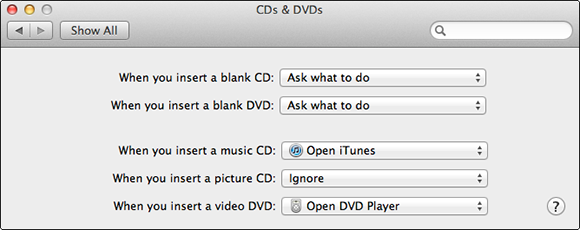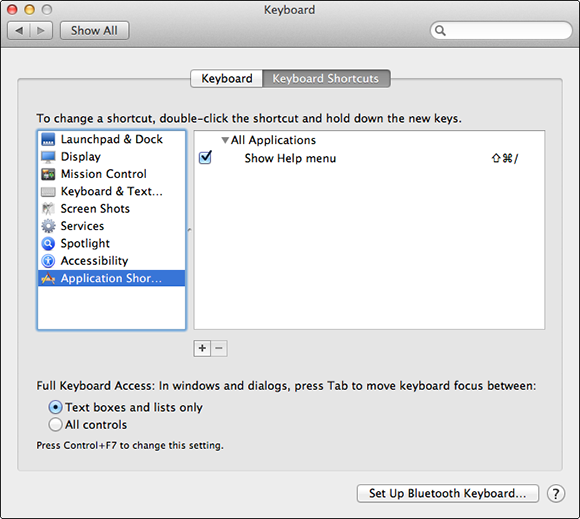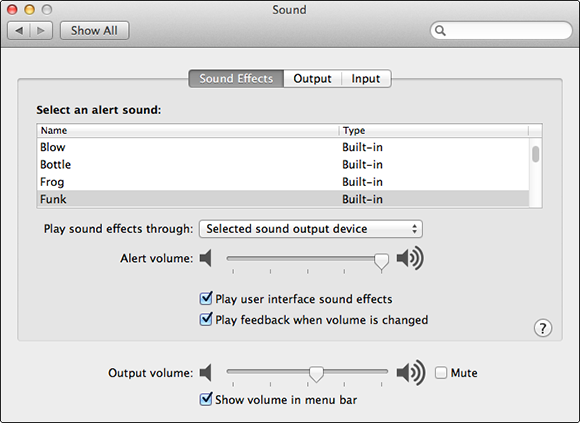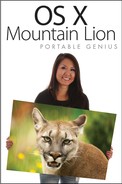Hardware
The Hardware section of System Preferences lets Mountain Lion know how you want it to interact with the various hardware components of your Mac. For information on the Print & Scan preferences, see Chapter 13.
CDs & DVDs
When you insert a CD or DVD into the Mac disc drive, something’s going to happen; what that is, however, is entirely up to you. The CDs & DVDs preferences pane lets you tell Mountain Lion how it should behave when you insert a disc, as shown in Figure 3.8.

3.8 Tell Mountain Lion how to handle CDs and DVDs from here.
Displays
The Displays preferences help you set the resolution of the Mac monitor or screen. The options in both tabs of the pane, Display (see Figure 3.9) and Color, are standard on any computer. There is a third tab called Arrangement that appears if you connect a second display to your Mac. Follow the instructions in the Arrangement tab to set up an extra display.

3.9 Adjust the monitor settings under the Display tab in the Display preferences pane.
The Display tab allows you to change these settings (some settings may not appear, depending on what type of display you are using):
![]() Resolutions. Lets you choose the amount of detail your screen shows. The higher the resolution, the smaller the items are on your screen; the lower the resolution, the larger the items are.
Resolutions. Lets you choose the amount of detail your screen shows. The higher the resolution, the smaller the items are on your screen; the lower the resolution, the larger the items are.
![]() Refresh rate. Determines how often the display is redrawn. If you aren’t using a Mac with a built-in display, such as a laptop or an iMac, consult the documentation that came with your monitor for appropriate refresh rates.
Refresh rate. Determines how often the display is redrawn. If you aren’t using a Mac with a built-in display, such as a laptop or an iMac, consult the documentation that came with your monitor for appropriate refresh rates.
![]() Gather windows. Click this button to move all Display preferences panes to the display the button is available on. You must be using multiple displays to see this button.
Gather windows. Click this button to move all Display preferences panes to the display the button is available on. You must be using multiple displays to see this button.
![]() Rotation. This option allows you to rotate the images on your display by the amount you select.
Rotation. This option allows you to rotate the images on your display by the amount you select.
![]() Brightness. Drag the slider to increase or decrease the brightness of your display.
Brightness. Drag the slider to increase or decrease the brightness of your display.
![]() Show displays in menu bar. Select this check box to place a shortcut to the Display preferences in the menu bar.
Show displays in menu bar. Select this check box to place a shortcut to the Display preferences in the menu bar.
![]() Show mirroring options in menu bar. Select this check box to place a shortcut to the mirroring options (when using multiple monitors) in the menu bar.
Show mirroring options in menu bar. Select this check box to place a shortcut to the mirroring options (when using multiple monitors) in the menu bar.
![]() Overscan. Should you be using a TV as a display you may not be able to see the menu bar at the top of the screen. If this is the case, simply enable this option to see the menu bar.
Overscan. Should you be using a TV as a display you may not be able to see the menu bar at the top of the screen. If this is the case, simply enable this option to see the menu bar.
The Color tab is where you can set your display to use color profiles so that it can represent colors more accurately. Deselect the Show profiles for this display only check box to see all profiles installed on your Mac.

Sometimes the best color is what suits your eye, rather than what Mountain Lion automatically chooses for your monitor. You can create a custom profile for your monitor to use by clicking Calibrate and following the instructions. If color matching is old hat to you, select the Expert Mode check box in the Display Calibrator Assistant Introduction screen to gain access to a more finely tuned process.
Energy Saver
Everyone’s trying to be a bit greener these days, and Mountain Lion is no exception. The Energy Saver preferences provide settings for your computer, hard drive, and display to sleep when they are inactive for the period of time that you set by dragging the sliders, as shown in Figure 3.10.

The Energy Saver preferences differ slightly depending on whether you are on a notebook or desktop.

3.10 Save energy by having your display and computer go to sleep when not in use.
Click the Battery, Power Adapter, or UPS tab in the Energy Saver preferences pane to set these options (options may differ depending on the type of Mac you have):
![]() Put the hard disk(s) to sleep when possible. Puts the hard drive to sleep whenever it’s inactive.
Put the hard disk(s) to sleep when possible. Puts the hard drive to sleep whenever it’s inactive.
![]() Slightly dim the display when using this power source. Lowers the brightness when the power source is switched to the battery.
Slightly dim the display when using this power source. Lowers the brightness when the power source is switched to the battery.
![]() Wake for network access. Wakes your Mac up when a network administrator is trying to access it through the network.
Wake for network access. Wakes your Mac up when a network administrator is trying to access it through the network.
![]() Automatically reduce brightness before display goes to sleep. The brightness on your display decreases a couple of minutes before it goes to sleep when it’s not in use.
Automatically reduce brightness before display goes to sleep. The brightness on your display decreases a couple of minutes before it goes to sleep when it’s not in use.
![]() Start up automatically after a power failure. Select this option to have your Mac restart on its own after an interruption in power.
Start up automatically after a power failure. Select this option to have your Mac restart on its own after an interruption in power.
![]() Restart automatically if the computer “freezes.” Selecting this option causes your Mac to restart automatically should it experience a freeze (become totally unresponsive).
Restart automatically if the computer “freezes.” Selecting this option causes your Mac to restart automatically should it experience a freeze (become totally unresponsive).
![]() Show battery status in menu bar. Places a battery icon in the menu bar on a laptop, allowing you to easily monitor the amount of remaining charge.
Show battery status in menu bar. Places a battery icon in the menu bar on a laptop, allowing you to easily monitor the amount of remaining charge.
![]() Schedule. The Schedule options let you set up a daily schedule for turning your Mac on and off or putting it to sleep.
Schedule. The Schedule options let you set up a daily schedule for turning your Mac on and off or putting it to sleep.
Keyboard
The Keyboard preferences pane gives you two tabs — Keyboard and Keyboard Shortcuts — to configure how your keyboard interacts with Mountain Lion. You can also set up a wireless keyboard using Bluetooth and create your own keyboard shortcuts.
Click the Keyboard tab to modify how quickly the keyboard responds to a key press or whether to automatically illuminate your keyboard in low-light settings. The available options are self-explanatory, but if you need further help, click the Help button (the question mark) in the lower-right corner of the window.
I love the fact that Apple gives you the opportunity to make your own keyboard shortcuts for applications under the Application Shortcuts section of the Keyboard Shortcuts tab, shown in Figure 3.11. Click the plus sign (+) in the lower-left corner to create a new one or highlight a shortcut in the list and click the minus sign (–) to delete it. To disable a shortcut, simply deselect the check box next to it. You can also enable or disable shortcuts for the other sections in the Keyboard Shortcuts tab, such as Services and Spotlight.

3.11 Create and modify your own keyboard shortcuts.
Mouse
The Mouse preferences pane gives you the ability to configure how your mouse behaves with Mountain Lion. You can also set up a wireless mouse using Bluetooth. Mountain Lion determines the kind of mouse you have and gives you the options necessary for configuring its operation, but you see something similar to what is shown in Figure 3.12.

3.12 Mountain Lion lets you configure your mouse according to its capabilities.
Trackpad
The Trackpad preferences pane, shown in Figure 3.13, only appears if you are using a laptop or have a Magic Trackpad connected to your desktop Mac.
The Multi-Touch trackpads on Mac laptops provide some amazingly cool features that you can modify to your liking with the options in the Trackpad pane (the look of this pane differs if you’re using a laptop trackpad or the Magic Trackpad):
![]() Adjust tracking, double-click, and scrolling speeds using their respective sliders.
Adjust tracking, double-click, and scrolling speeds using their respective sliders.
![]() Customize trackpad gestures for scrolling, zooming, dragging, rotating, swiping, pinching, and clicking. Apple has provided a great visual help with the gestures by using short video clips that illustrate each type.
Customize trackpad gestures for scrolling, zooming, dragging, rotating, swiping, pinching, and clicking. Apple has provided a great visual help with the gestures by using short video clips that illustrate each type.

3.13 Tweak the trackpad settings to reflect the way you work.
Sound
Configure the Mac sound in the Sound preferences pane, as shown in Figure 3.14.

3.14 Change your Mac sounds using the Sound preferences.
Table 3.1 gives a brief overview of each tab in the pane.

Ink
Ink is available only if you have a graphics tablet connected to your Mac. It allows you to use the graphics tablet as an alternative input method. Ink will recognize your handwriting and translate it into text, as an alternative to typing.
